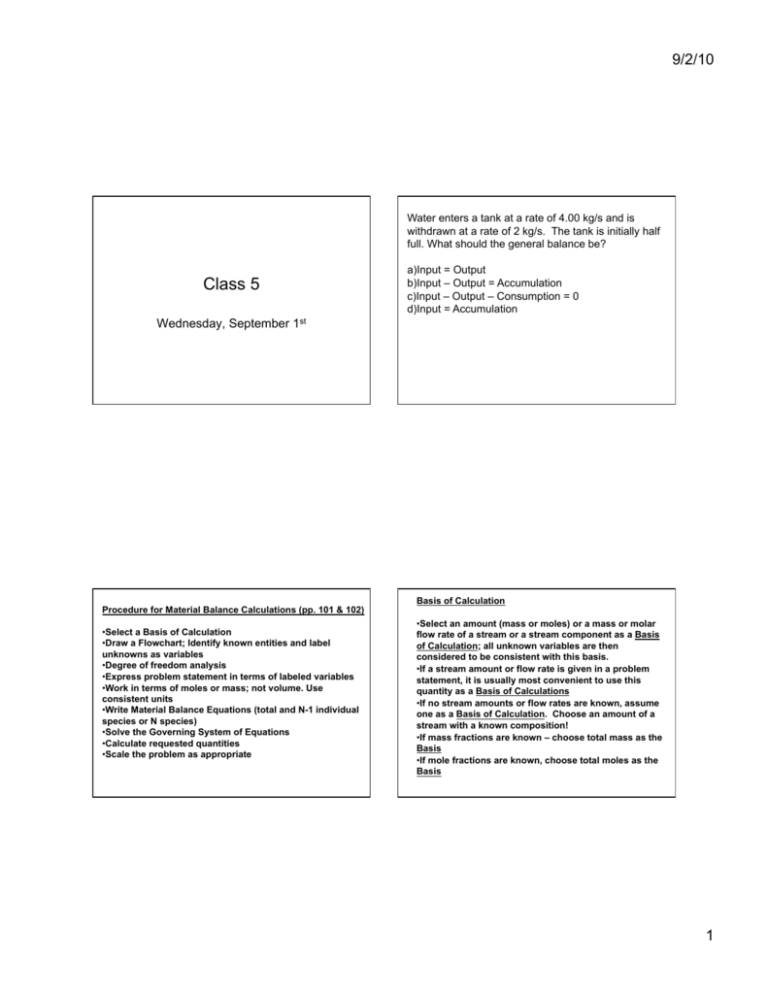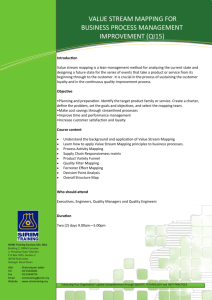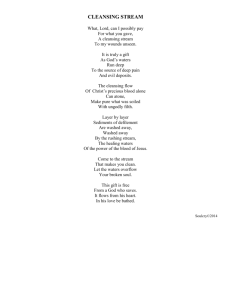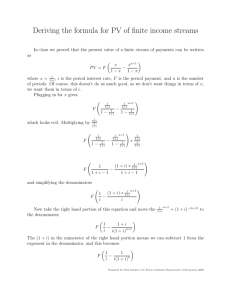class 5
advertisement

9/2/10 Water enters a tank at a rate of 4.00 kg/s and is withdrawn at a rate of 2 kg/s. The tank is initially half full. What should the general balance be? Class 5 a) Input = Output b) Input – Output = Accumulation c) Input – Output – Consumption = 0 d) Input = Accumulation Wednesday, September 1st Procedure for Material Balance Calculations (pp. 101 & 102) • Select a Basis of Calculation • Draw a Flowchart; Identify known entities and label unknowns as variables • Degree of freedom analysis • Express problem statement in terms of labeled variables • Work in terms of moles or mass; not volume. Use consistent units • Write Material Balance Equations (total and N-1 individual species or N species) • Solve the Governing System of Equations • Calculate requested quantities • Scale the problem as appropriate Basis of Calculation • Select an amount (mass or moles) or a mass or molar flow rate of a stream or a stream component as a Basis of Calculation; all unknown variables are then considered to be consistent with this basis. • If a stream amount or flow rate is given in a problem statement, it is usually most convenient to use this quantity as a Basis of Calculations • If no stream amounts or flow rates are known, assume one as a Basis of Calculation. Choose an amount of a stream with a known composition! • If mass fractions are known – choose total mass as the Basis • If mole fractions are known, choose total moles as the Basis 1 9/2/10 Degree of freedom Analysis # of unknowns - # of equations we can write = degrees of freedom DOF = 0 DOF > 0 DOF < 0 system solvable need more info to solve overspecified One thousand kilograms per hour of a mixture containing equal parts by mass of methanol and water is distilled. Product streams leave the top and the bottom of distillation column. The flow rate of the bottom stream is measured and found to be 673 kg/h, and the overhead stream is analyzed and found to contain 96.0 wt% methanol. a) Draw and label flowchart and do degree of freedom analysis. Equations we can write Material balances (one for each independent species) Process specifications Physical properties and laws Physical constraints Energy balance Can also assume a basis if no stream is given • Select a Basis of Calculation • Draw a Flowchart; Identify known entities and label unknowns as variables • Do degree of freedom analysis YAY!!!! One thousand kilograms per hour of a mixture containing equal parts by mass of methanol and water is distilled. Product streams leave the top and the bottom of distillation column. The flow rate of the bottom stream is measured and found to be 673 kg/h, and the overhead stream is analyzed and found to contain 96.0 wt% methanol. b) Calculate mass and mole fractions of methanol and molar flow rates of methanol and water in the bottom product stream. • Express problem statement in terms of labeled variables Calculate mass and mole fractions of methanol and molar flow rates of methanol and water in the bottom product stream. 2 9/2/10 • Write Material Balance Equations • Solve the Governing System of Equations • Calculate requested quantities A stream of air that is saturated with acetone enters a condenser where 80 % of the acetone is condensed. The flow rate into the condenser is 100 g/min. Consider air to be one species. Find the flow rate of the gas stream leaving the condenser and the mole fractions of air and acetone in this stream. How many degrees of freedom are there? a) 0 b) 1 c) 2 d) 3 Calculate mass and mole fractions of methanol and molar flow rates of methanol and water in the bottom product stream. A stream of air that is 10 mole % acetone enters a condenser where 80 % of the acetone is condensed. The flow rate into the condenser is 100 g/min. Consider air to be one species. Find the flow rate of the gas stream leaving the condenser and the mole fractions of air and acetone in this stream. How many degrees of freedom are there? a) 0 b) 1 c) 2 d) 3 An aqueous solution of HCl contains 15 % HCl by mass. It is desired to produce a 5% HCl solution by diluting a stream of the 15 % solution with pure water. Calculate liters of H2O/kg feed solution and kg product solution/kg feed solution. Do same problem assuming that you need to make 100 kg of the 5 % solution. Plan: Change flow in to moles. Do overall balance and acetone balance. Find mole fractions in gas stream from condenser. 3 9/2/10 An aqueous solution of HCl contains 15 % HCl by mass. It is desired to produce a 5% HCl solution by diluting a stream of the 15 % solution with pure water. Calculate liters of H2O/kg feed solution and kg product solution/kg feed solution. An aqueous solution of HCl contains 15 % HCl by mass. It is desired to produce a 5% HCl solution by diluting a stream of the 15 % solution with pure water. Calculate liters of H2O added/kg feed solution and kg product solution/kg feed solution. How many DOF’s? a) 0 b) 1 c) 2 d) 3 An aqueous solution of HCl contains 15 % HCl by mass. It is desired to produce a 5% HCl solution by diluting a stream of the 15 % solution with pure water. Do same problem assuming that you need to make 100 kg of the 5 % solution. 4








